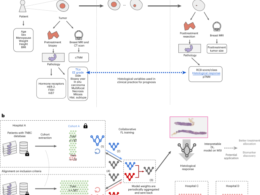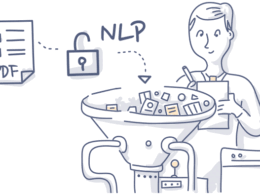health and tech institute (hti)
research and strategy institute
for continuous health transformation
Joaquim Cardoso MSc
Founder and Chief Researcher & Editor
February 20, 2023
EXECUTIVE SUMMARY
Introduction
In this editorial, written for the centennial of Radiology, the future of breast imaging over the next 20–30 years is discussed.
Covered topics include current issues and future directions in breast cancer screening, diagnosis, and treatment guidance .
Current Issues and Future Directions in Breast Cancer Screening, Diagnosis, and Treatment
1.To state that nowadays the need for screening will de-crease because targeted systemic treatment is so effective is to confuse cause and effect
2.In the future, mammographic screening will only be used in a minority of women: those at low risk and with involuted breasts
3.The selection of appropriate outcome metrics and generation of the necessary evidence is also challenging for the clinical evaluation of diagnostic methods used to guide treatment;
this explains why, during the past decades, we have been fairly unsuccessful in integrating imaging for personalized cancer care
4.Radiologists must own the interpretation of their research data and lead the medical community when setting up practice guidelines that involve the use of imaging for screening or treatment planning
5.Artificial intelligence will not only be used for predicting individual women’s risk and for phenotyping of cancer, but also for the acquisition and interpretation of all screening studies
Where Do We Go from Here?
Extrapolating the change in breast cancer imaging I have seen over the past 20 years — it could be that nothing relevant changes at all.
Radiologists may continue to cling to mammographic screening — for ease of use and personal convenience.
We may continue to discuss the use of improved screening methods while thousands die of breast cancer.
We may continue to discourage the use of modern imaging for surgical treatment while hundreds of thousands of patients undergo several rounds of surgery for free margins.
We may continue missing the opportunity to exploit imaging to better guide treatment.
With the enthusiastic new generation of radiologists that I have the privilege to work with, the author is optimistic that things will change.
DEEP DIVE

What the Future Holds for the Screening, Diagnosis, and Treatment of Breast Cancer
Radiology (RSNA)
Christiane K. Kuh
Feb 7 2023
I.SCREENING
Breast Cancer Screening: The Current Situation
Breast cancer is the most common type of cancer in women in the Western world (1).
Quality-assured breast cancer screening programs have been established in the United States as well as most European countries.
Yet, breast cancer continues to represent the first or second most important cause, respectively, of cancer death in women in those countries — including those participating in screening (1,2).
This tells us that mammographic screening is not good enough for too many women.
We need to substantially improve early detection to reduce breast cancer mortality.
Considering these facts, it is surprising that current screening is critiqued mainly because of false-positive diagnoses and overdiagnosis of indolent disease (3).
In reality, the major problem of current breast screening is underdiagnosis: Failure to identify cancer early enough to prevent morbidity and mortality from breast cancer.
In reality, the major problem of current breast screening is underdiagnosis: Failure to identify cancer early enough to prevent morbidity and mortality from breast cancer.
Early diagnosis with systematic screening helps to avoid a diagnosis of cancer that is already in a metastatic stage.
But that is not its only benefit.
Early diagnosis also detects cancers before clonal evolution and diversification can occur.
This is important because clonal diversification can cause biologically indolent cancer cells to de-differentiate (ie, lose features of normal cells). Clonal diversification thus escalates cell growth and their ability to metastasize (4).
Clonal diversification also increases the likelihood that resistant cell clones develop, which help cancers escape targeted therapies.
Therefore, to state that nowadays the need for screening will decrease because targeted systemic treatment is so effective is to confuse cause and effect:
Targeted therapy is successful because more patients are in an early stage.
Early diagnosis of cancer and modern, targeted treatment strategies are therefore synergistic measures — not competitors.

Future Screening: Risk-adjusted, Individualized
Breast cancer screening will become personalized.
The current one-size-fits-all approach to mammographic screening will be abandoned.
Instead, women will have different breast screening pathways and will not remain on the same pathways as they age.
Personalized breast cancer screening requires precise information on each woman’s short- and intermediate-term risk of developing breast cancer, including the likelihood of cancers not being visible at specific imaging methods.
Such risk assessment methods must be available on a population-wide level.
In the not-so-distant future, we will use imaging for this purpose.
Features retrieved from mammograms (5–7) and from functional methods like MRI (8) provide impressively accurate information on individual women’s risk.
Currently, artificial intelligence (AI)–based analyses of mammograms already outperform traditional risk assessment models based on personal and family history, like the Tyrer-Cuzick risk model.
Unlike the Tyrer-Cuzick model, AI-based risk assessment of imaging studies appears to be more robust across different ethnicities, and it neither requires office visits nor relies on information that many individuals may not even know (7).
Such imaging-based risk assessment will be amended by predictive genomic information obtained by means of a liquid biopsy, which samples body fluid (eg, blood, urine) to look for circulating cancer DNA.
Such liquid-based biopsy methods are still in their infancy, and their accuracy is currently insufficient to allow diagnosis of early cancer.
Rather, these methods are used to define an at-risk cohort to undergo intense imaging to confirm or refute the presence of cancer, similar to current prostate-specific antigen, or PSA, screening (9).
Large randomized controlled trials are currently underway (10).
A detailed risk assessment will also help overcome the current age-based criteria regarding when to start and end screening.
For instance, women under 50 are currently excluded from screening. Yet, breast cancer is a leading cause of death in this group.
Indeed, more women with breast cancer diagnosed between 40 and 50 die of the disease than those currently offered screening.
Thus, offering more effective breast cancer screening methods to these younger women is essential to avoid a major cause of life years lost in the female population overall.

Future Screening: Methods
In the future, mammographic screening will only be used in a minority of women: those at low risk and with involuted breasts.
Functional, likely angiogenesis-based imaging methods will be used on a population-wide scale.
Today, contrast-enhanced mammography (CEM) (11) and (abbreviated) breast MRI (12) are the main candidates for this.
Interestingly for CEM screening, more meta-analyses than original articles seem to have been published.
In contrast, evidence from randomized controlled clinical trials is available for MRI screening (13).
Emerging data demonstrate that MRI is superior to CEM (14,15).
Thus, it is difficult to justify the use of CEM when superior diagnostic information is available without exposing healthy individuals to ionizing radiation.
Women themselves will also prefer imaging methods like MRI that do not require breast compression.
With CEM, 100–120 mL of iodinated contrast agent is injected, with known rates of adverse effects or contrast agent–induced nephropathy. With MRI, we will use no more than 2–3 mL of stable (ie, nondepositing) high-relaxivity gadolinium chelates (16) or iron-based contrast agents (17). In the intermediate term, the use of AI will further reduce the need for contrast agents (18).
Eventually, unenhanced MRI techniques, such as novel diffusion-weighted imaging methods or MRI fingerprinting, will replace the functional information now provided by contrast agents (19,20).
In the not-so-far future, dedicated breast MRI systems optimized to support high-volume screening will provide a more comfortable experience for individuals undergoing screening.
These magnets will be lightweight, easy to site, less noisy, will not require helium for cooling, and will need as little electricity as a toaster.

II.TREATMENT
Future Treatment Guidance: Local
Methods of precision imaging will improve local treatment of breast cancer — and help deescalate it.
For all patients, current breast-conserving treatment consists of surgery until tumor-free margins are achieved, followed by whole-breast radiation therapy, plus at least antihormonal therapy and/or chemotherapy.
This constitutes considerable overtreatment for many. Radiation therapy, for instance, helps avoid future in-breast recurrence but has never, to my knowledge, convincingly demonstrated an effect on survival (21,22).
Given this intent — preventing local recurrences — it is implausible that health care providers insist on radiation therapy for every patient who undergoes breast conservation but choose not to use MRI to be informed about existing additional cancers in the same or the opposite breast. PROSPECT (Post-operative Radiotherapy Omission in Selected Patients with Early Cancer Trial) is a landmark trial in this regard.
It is the first to make use of MRI to avoid radiation therapy by selecting a subset of patients with truly solitary disease.
The trial also demonstrates that lumpectomy of these additional cancers is sufficient (no mastectomy needed for multicentric disease) and that this lumpectomy of additional disease improves local control — regardless of radiation therapy (23).
In case surgery continues to represent a major component of future breast cancer treatment, …
… it will be essential to develop fundamentally improved methods to translate complex imaging information into the operating room to allow surgeons to really use this information to define resection margins intraoperatively.
The crude methods we currently use for localization (ie, seeds, wires, and bracketing) are not even remotely abreast with the advances that have been made in imaging (24).
More likely, the need for surgical treatment of breast cancer will further subside due to the increasing effectiveness of screening and systemic treatment.
Eventually, surgery will be replaced by (vacuum) ablation under imaging guidance (25,26).

Future Treatment Guidance: Systemic
There is a substantial need for reliable predictive and prognostic information to better tailor systemic treatment to the individual biologic aggressiveness of each cancer.
Such information is so far based on histopathologic and genomic features.
However, the clinical “performance” of a cancer is not only determined by its own resources (ie, its genomics).
Rather, it is largely modulated by its microenvironment (27). Functional imaging methods like multiparametric MRI (28) or dedicated breast PET/MRI (29) capture this interplay of nature (genomics) and nurture (environment) of the “living” cancer in its natural environment and do so for the entire cancer — not only for small pieces.
AI-based analyses of such tumor phenotyping will provide predictive and prognostic information complementary to genomics-based profiling (30).
Novel potent whole-body staging methods like whole-body MRI or total-body (long axial field of view) PET (31) will not be broadly used to guide systemic treatment until they have been integrated for patient stratification in pharmaceutical clinical trials.
With the emerging field of immune-oncology, anticancer immunotherapy may be combined with local nonthermal ablation to help release intracellular cancer antigens and promote local proinflammatory effects.
The latter allows T cell–activating dendritic cells to accumulate at the site of the cancer; together with the former, a powerful systemic anticancer immunization may occur that could help overcome immune-escape mechanisms.
Thus, local and minimally invasive interventional treatment could be used to improve systemic control (32), until, in the far future, we might have effective anticancer vaccinations (eg, messenger RNA–based vaccines) (33).

III.RESEARCH
Future Research: Screening
Breast radiologists are well aware that randomized controlled trials with appropriate end points are necessary to pave the way for improved screening.
However, when modern imaging methods are used in trials powered to assess meaningful outcome metrics, financial resources are required that can only be procured on a national or even supranational level.
So, this is what hampers clinical research in breast imaging — not ignorance of the type of evidence that we need to provide.
Unfortunately, unlike in the field of oncology, in radiology there is no industry that runs randomized controlled clinical trials.
The U.S.-based Cancer Research Group ECOG-ACRIN has been instrumental in this regard.
Yet, to ensure that funding for the necessary clinical trials will be available, it will be essential that other countries set up similar research platforms.
Radiologic societies must coordinate their efforts to inform policymakers of the importance of such trials for population health and cost containment in health care.
For future screening trials, it will be crucial that radiologists sit in the driver’s seat to ensure that the right outcome metrics are chosen, because this choice is challenging and requires radiologic expertise.
For example, although mortality is the appropriate end point to evaluate screening, its assessment takes several decades of follow-up.
Thus, mortality is not a useful end point to answer questions regarding today’s screening methods.
Therefore, surrogate end points should be used as proxies. This must be done with caution.
Of key importance is to sort out whether additional cancers detected with new screening methods truly reduce underdiagnosis or only add overdiagnosis.

Future Research: Treatment Guidance
The selection of appropriate outcome metrics and generation of the necessary evidence is also challenging for the clinical evaluation of diagnostic methods used to guide treatment; …
… this explains why, during the past decades, we have been fairly unsuccessful in integrating imaging for personalized cancer care.
Take breast MRI as an example. MRI has many unique abilities that are not currently used.
First, the unique ability of MRI for delineating the true extent of disease has been known for decades, but it is still not used to guide resections — resulting in persistently high re-excision rates (24).
Second, the unique ability of MRI for demonstrating presence or absence of additional cancers in the same or opposite breast is not used — instead, whole-breast irradiation and antihormonal treatment are perceived as inevitable to prevent in-breast recurrences.
Third, the unique ability of MRI for early identification of nonresponders to systemic treatment is not used because MRI has never been implemented in adaptive clinical trials — accordingly, no guideline tells us how to act on the MRI diagnoses.
Finally, the unique ability of whole-body PET/MRI to detect metastatic deposits has not been used to stratify patients with versus without metastases in pharmaceutical trials — therefore, it is not included in guidelines on systemic treatment decisions. Indeed, recent treatment guidelines do not recommend any staging examinations at all except for specific cancer subtypes.
Thus, rather than knowing what a breast cancer has already “achieved” at the time of diagnosis, management decisions are increasingly based on pure molecular characterization of local cancer.
To be more successful in the future, radiologists must proactively team up with cooperative oncology groups and the pharmaceutical industry to involve modern imaging in their clinical trials.
This combined effort will also avoid the progressive marginalization of imaging information from molecular biology.

IV.RADIOLOGISTS
Self-Empowerment of Radiologists
Radiologists must own the interpretation of their research data and lead the medical community when setting up practice guidelines that involve the use of imaging for screening or treatment planning.
Currently, nonradiologists (eg, epidemiologists, health economists, surgeons, oncologists) appear to be perceived as neutral experts and as a reliable source of judgment in this regard (34).
This must change.
There is no other clinical specialty that is not responsible for establishing evidence-based guidelines for its own clinical practice.
Oncologists issue guidelines on the use of chemotherapy.
Radiation oncologists issue guidelines on the use of radiation therapy.
Yet, no one ever suspects a conflict of interest for these specialties. The same should be assumed for radiologists.

V.Artificial Intelligence
How Will AI Change the Situation?
AI will not only be used for predicting individual women’s risk and for phenotyping of cancer, but also for the acquisition and interpretation of all screening studies.
AI will accelerate image acquisition for screening examinations, possibly down to a couple of seconds by exploiting the concept of ultrafast MRI (35), combined with AI to interpret the resulting data.
Indeed, algorithms will be used to recover information from greatly curtailed imaging data, perhaps even directly from the k-space domain (ie, data not interpretable by humans).
Radiologists should welcome the help of AI.
In screening, several hundred negative studies have to be read to identify a single individual with cancer — an inhuman task.
It is against human nature to mostly “not find” when we are in search mode.
Radiologists will not become jobless in view of the individualization and expansion of age-related preventative screening, not to mention our increasing noninterpretative responsibilities.
Radiologists will not become jobless in view of the individualization and expansion of age-related preventative screening, not to mention our increasing noninterpretative responsibilities.

VI.NEXT STEPS
Where Do We Go from Here?
Extrapolating the change in breast cancer imaging I have seen over the past 20 years — it could be that nothing relevant changes at all.
Radiologists may continue to cling to mammographic screening — for ease of use and personal convenience.
We may continue to discuss the use of improved screening methods while thousands die of breast cancer.
We may continue to discourage the use of modern imaging for surgical treatment while hundreds of thousands of patients undergo several rounds of surgery for free margins.
We may continue missing the opportunity to exploit imaging to better guide treatment.
With the enthusiastic new generation of radiologists that I have the privilege to work with, I am optimistic that things will change.
It is up to us.
About the author & affiliations
Christiane K. Kuh
From the Department of Diagnostic and Interventional Radiology, University Hospital Aachen, Pauwelsstr 30, 52074 Aachen, RWTH, Germany.
Originally published at https://pubs.rsna.org
References:
See the original publication












